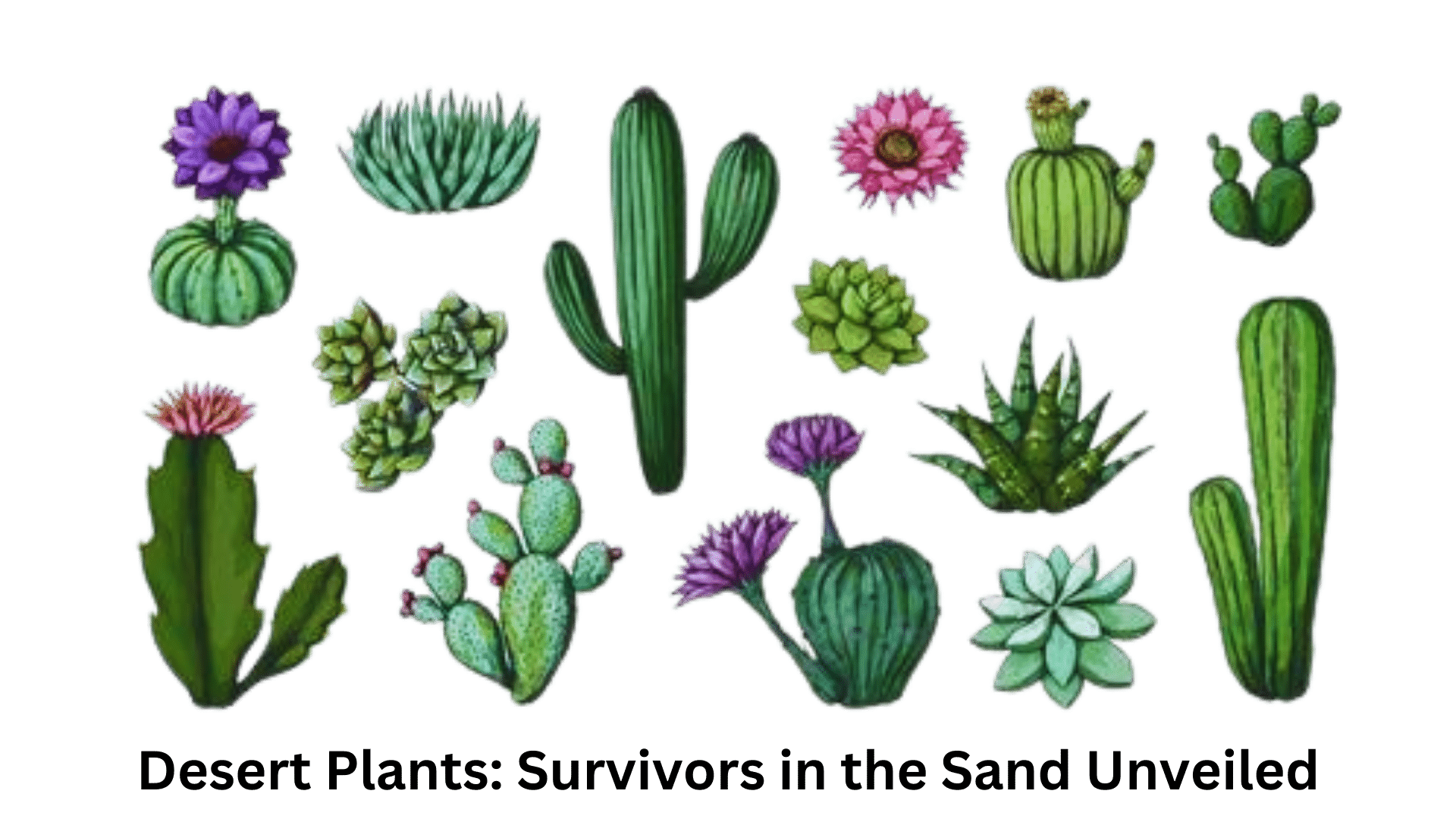Introduction
In arid landscapes where the sun beats relentlessly, and water is a scarce commodity, desert plants stand as silent but remarkable testimony to nature’s ability to adapt and thrive in the most challenging environments. Let’s delve into the fascinating world of desert flora and explore the unique features that enable these plants to flourish in the harsh conditions of the desert.
Adaptations for Aridity: How Desert Plants Conserve Water
Structural Adaptations
Desert plants have changed their structures in many ways to deal with not having enough water. One of these changes is the appearance of cells that are succulent and store water, like the saguaro cactus. These plants can store a lot of water for times when it doesn’t rain much, which lets them survive long droughts.
Reduced Leaf Surface Area
Desert plants often have smaller leaf surfaces or leaves that have been changed in some way, like adding spines or scales. This is done so they lose less water through evaporation. This makes less of the plant’s surface open to the dry, hot air, which helps it save water.
Root Adaptations
Desert plants often have deep and extensive root systems to tap into underground water sources. Some, like the mesquite tree, have taproots that can reach deep aquifers, ensuring a constant supply of water even in arid conditions.
Water-Storage Strategies
Some dry plants, like the barrel cactus, have special tissues that can grow and shrink. This lets them store water and release it when they need to. Because of these changes, these plants can live long droughts and wait calmly for the next rain.
Mastering Survival: Strategies for Thriving in Extreme Temperatures
Temperature Regulation
Temperatures in the desert change a lot, from very hot during the day to very cold at night. Many desert plants have found ways to keep their internal temperatures stable so they can survive these high temperatures. Some, like the creosote bush, have surfaces that reflect too much sunlight and bounce it off, while others have special layers that keep the temperature stable.
Nocturnal Blooms
To avoid the harsh daytime heat and conserve water, some desert plants, like the night-blooming cereus, have adapted to bloom at night. This not only ensures better pollination success but also reduces water loss through transpiration during the scorching daylight hours.
Camouflage and Shade Strategies
Certain desert plants have evolved to provide shade for themselves and neighbouring plants. The umbrella-like canopy of the acacia tree, for instance, not only shields itself from the sun but also creates a cooler microenvironment underneath, benefiting other plants and animals in the vicinity.
Blossoming in Adversity: Desert Plants and Their Remarkable Reproductive Strategies
Delayed Germination
In the unpredictable desert environment, where rain may be sporadic, some plants have evolved delayed germination. Seeds remain dormant until conditions are favorable for growth, ensuring the survival of the next generation.
Efficient Pollination
These plants often rely on specialized pollination strategies. Some, like the Joshua tree, depend on nocturnal pollinators, such as moths, to transfer pollen between flowers. These adaptations ensure the continuation of the plant species even in the harsh desert climate.
Seed Dispersal
To colonize new areas and increase the chances of survival, these plants often have evolved unique seed dispersal mechanisms. This can include adaptations for wind dispersal, hitching a ride on passing animals or utilizing water channels during rare rain events.
The Role of Desert Plants in Ecosystems: A Delicate Balance
Ecosystem Engineers
Even though their environments don’t look very friendly, these plants are very important for keeping communities unique. Many animals, from insects to mammals, use them as protection and eat the food they provide. In these sensitive areas, their roots also help keep the earth stable, which stops runoff.
Medicinal and Cultural Significance
Indigenous peoples have made extensive use of the medicinal and cultural potential of a great number of these plants for hundreds of years. For instance, the aloe vera plant is revered for its capacity to treat a variety of ailments, but the yucca plant has a long history of use in the manufacture of implements and baskets.
Carbon Sequestration
Plants in deserts, especially those with deep roots, help store carbon in the soil, which is called carbon storage. This not only helps fight climate change, but it also makes the land more fertile in these tough places.
| Plant Name | Scientific Name | Habitat | Description | Adaptations & Survival Strategies |
|---|---|---|---|---|
| Saguaro Cactus | Carnegiea gigantea | Sonoran Desert, Arizona, Mexico | Tall, columnar cactus with “arms” | Ribbed structure for water storage; shallow roots to capture surface rainfall |
| Barrel Cactus | Ferocactus spp. | Southwestern US, Mexico | Globular shape with prominent ribs | Thick, waxy skin to prevent water loss; capacity to expand to store water |
| Joshua Tree | Yucca brevifolia | Mojave Desert, California, Nevada | Unique, spiky tree with branching limbs | Long, deep taproots for accessing groundwater; waxy leaves to reduce evaporation |
| Desert Sage | Salvia dorrii | Arid regions of North America | Silver-gray leaves with fragrant purple flowers | Aromatic oils in leaves deter herbivores; reduced leaf surface to limit water loss |
| Prickly Pear Cactus | Opuntia spp. | North and Central America | Flat pads with spines and colorful fruits | Water-storing pads; modified leaves reduce water loss; spines deter predators |
Frequently asked questions
How do desert plants survive in such harsh environments?
Desert plants have adapted various survival strategies such as water storage in their tissues, reduced leaf surfaces to minimize water loss, and deep root systems to access groundwater.
Do desert plants need water to survive?
Yes, they do. While they are adapted to arid conditions, all plants require water. Desert plants have specialized mechanisms to store and efficiently use water.
What adaptations do cacti have for survival in deserts?
Cacti have thick, waxy skin to prevent water loss, water-storing tissues in their stems, and shallow but extensive root systems to absorb surface moisture quickly.
How do desert plants protect themselves from predators?
Some desert plants have spines or thorns that deter animals from feeding on them. Others produce chemical compounds or have bitter-tasting leaves to discourage herbivory.
Can desert plants bloom or produce flowers?
Yes, many desert plants bloom, often producing vibrant and colorful flowers. Some species may have specific blooming periods tied to seasonal changes or rainfall.
Are all desert plants succulents?
Not all, but many desert plants are succulents. Succulents are plants that store water in their leaves, stems, or roots, and they’re well-suited for arid environments.
How can I care for desert plants in non-desert environments?
Provide them with ample sunlight, well-draining soil, and infrequent but deep watering to mimic their natural environment. Avoid overwatering, as this can cause root rot.
Do desert plants have medicinal properties?
Some desert plants, like Desert Sage and certain cacti species, have been used traditionally for medicinal purposes by indigenous cultures for various ailments.
Can desert plants be grown indoors?
Yes, many desert plants can be grown indoors, provided they receive sufficient sunlight and proper care. Select species that can thrive in container environments.
Are there endangered desert plant species?
Yes, due to habitat destruction and climate change, several desert plant species are endangered or threatened. Conservation efforts are in place to protect these species.

Conclusion: Celebrating the Tenacity of Desert Flora
In conclusion, the world of desert plants shows how naturally flexible and strong nature is. These plants have not only lived through some of the worst situations on Earth, they have even done well in them. As we are amazed by how they have changed to survive, we gain a better understanding of how complicated nature is and how beautiful it can be even in the harshest places. Desert plants aren’t just survivors; they build communities that do well in some of the harshest environments. This shows how resilient life is in the desert.

